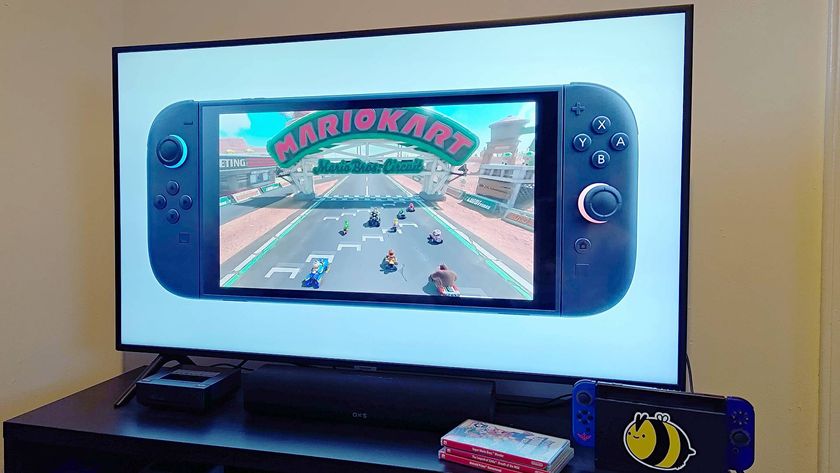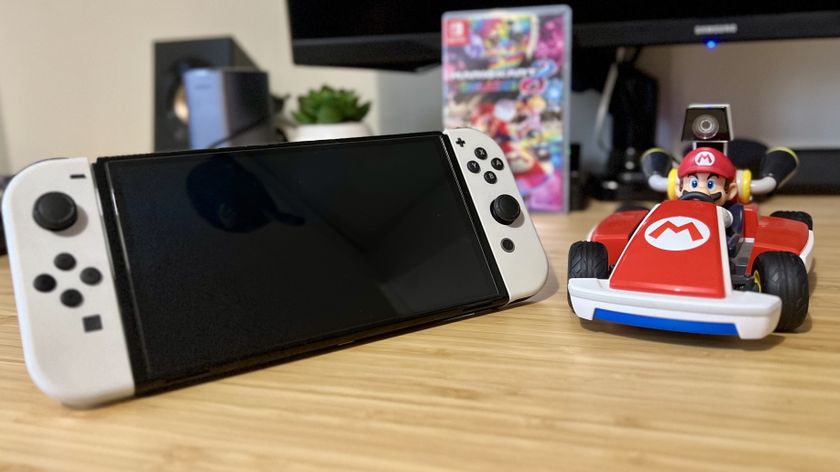Nintendo Switch OLED vs Nintendo Switch: Nintendon't do 4K
Not sure if the Nintendo Switch OLED is worth your money? Let's take a look at what's new

So you're weighing up the Nintendo Switch OLED vs Nintendo Switch? Stick with us as we compare the upcoming OLED model against the standard version. We'll tell you what's new and improved, talk about price (and value), and help you weigh up if the Switch OLED is right for you if you already have a Switch... or if it's the one to buy if you don't own any Switch console at all.
If you're super keen to find out how to buy one, then head on over to our Nintendo Switch OLED pre-order guide which has all the details you need to reserve one ahead of the October 8 release date - they're already in short supply, just so you know. We would of course advise checking out our comparison notes below first though, as you might find a regular cheap Nintendo Switch bundle is the better deal for your needs.
First things first: despite months, if not years, of speculation and demand, this is not a 4K Nintendo Switch Pro. So there's no resolution increase at all to enjoy Switch games in 4K while playing on modern TVs.
We don't mind telling you, but many of us here at GamesRadar think Nintendo has dropped the ball here as the new Switch OLED is, to cut a long story short, basically a slightly larger Switch, with a few minor quality of life improvements. It's Nintendo all over really, and we're mad at ourselves for expecting anything else. But is it a better Switch console? Let's dive in.

Nintendo Switch OLED vs Switch - display tech and size
The new Switch OLED has a larger display, coming in at 7 inches compared to 6.2 of the standard version. The console itself is only marginally larger as you're getting a thinner bezel, however. Plus, the new screen is now an OLED display instead of LED.
What does that mean? As we talk about in our best OLED TV guide, the new Switch OLED display means we can expect colors to be brighter with potentially a better range too. This could be great considering the fact that many of the best Nintendo Switch games are bursting at the seams with bright colors. Blacks could also appear to be much darker rather than washed out dark greys - which could be a timely fit for the new sinister vibe of Metroid Dread, which launches on the same day as the Switch OLED.
One thing we are slightly concerned about is that OLED screens are slightly susceptible to permanent burn-in (or temporary image retention), especially with static elements on the screen. Think health bars, ammo counters, and the like. So if you're regularly playing the same game over and over again, you might find they appear in very faded form in the background in other scenes. It's nowhere near as much of a problem as it was with plasma TVs, but certainly, something to consider.
Sign up to the 12DOVE Newsletter
Weekly digests, tales from the communities you love, and more

Nintendo Switch OLED vs Nintendo Switch - resolution
Ok, this one's hard to take. Despite the upgrade to an OLED screen on the Switch OLED, there is no bump in resolution for the display from the base Switch model. Both run at 720p in handheld mode and 1080p when playing in docked mode on TV.
The lack of 4K on the TV was bad enough for the Switch OLED, but not pumping up the handheld display to 1080p is just poor. That doesn't mean we won't see something resembling an actual Nintendo Switch Pro with 4K support further down the line, but we're much less optimistic now given Nintendo's inability to read the room. Or the year.

Switch OLED vs Switch - controllers
You'll be able to buy the Switch OLED with either traditional neon blue/red Joy-Cons, or in a new scheme with white controllers (along with a white dock). The Joy-Cons are the same as the original Switch's though and haven't changed in design or size. So yes, Joy-Con drift will inevitably rear its ugly head for plenty of buyers still.
Fortunately, your Nintendo Switch Pro controller will still work with the new Switch OLED, as will any third-party controllers, we imagine.
But we hope you two Labo owners at the back are listening, because Nintendo Labo games are not fully compatible with the Switch OLED's ever-so-slightly larger dimensions. Another unofficial nail in the Labo's coffin from Nintendo right there, if you were wondering how much longer the cardboard cul-de-sac had left before folding. At least it's recyclable.

Switch OLED vs Switch - the dock
Not only does the dock look a bit nicer with a few rounded edges and a white model being available if the black one is too dull for you, but the new Switch OLED dock now includes an ethernet/LAN port. Yes, that only highlights what should have been included with the original one, but here we are.
For most, the option of using a cabled broadband connection instead of Wi-Fi won't be a big deal at all. But if your Wi-Fi is a bit weak, this will improve your download speeds if you're able to get a cable over to your entertainment center.
A LAN connection might also be useful if you play a lot of super-competitive multiplayer games online, such as Smash Bros Ultimate, as it'll help cut down on latency. But this isn't really something that your average Switch owner will care about that much. You could also just buy a Switch LAN adapter for the older Switch. Nintendo has confirmed you'll eventually be able to buy the new Switch OLED dock to use on your old Switch, but we imagine it'll be much cheaper to buy the adapter instead.
The USB port on the back of the Switch OLED's dock has been removed, but you still have the two on the side, so this shouldn't cause any issues.

Switch OLED vs Switch - storage capacity
Hurrah, a genuine improvement. The Switch OLED comes with 64GB of built-in storage compared to 32GB in the original Switch. Yes, 64GB is still incredibly miserly, even with Switch games taking up nowhere near as much space as other consoles.
You're still going to need to pick up a cheap Switch memory card eventually, especially if you buy digital titles. We'd generally advise picking one up around 128GB.

Nintendo Switch OLED vs Nintendo Switch - audio
The built-in speakers on the Switch OLED are apparently getting an upgrade too. Nintendo isn't giving us much to go on so far though as the product listing page simply lists it as "Onboard speakers with enhanced audio".
Whether this means louder, or added bass, we'll simply have to wait until Nintendo shows the Switch OLED to the outside world. Generally, though, we imagine most people playing in handheld mode are using headphones. If you're not, and you're in a public area, congrats, you're a dick.
Bluetooth tech still hasn't been added for wireless gaming headsets, so you're still limited to 3.5mm or dongles. Check out our Nintendo Switch headset guide for some quality options though.

Nintendo Switch OLED vs Switch - the stand
If you have the original Switch, you might have suffered when propping it up on uneven surfaces thanks to the incredibly small and flimsy stand. If you're really unlucky, it might have even snapped off by now.
Nintendo does seem to be paying attention to some of our complaints though as the new stand is much wider and allows for multiple angles. If you play in tabletop mode a lot, this could be a big win for you.
Nevertheless, if that's your main beef with your current Switch, we'd advise checking out a cheap carry case with a built-in stand before splashing out $350 on the new Switch OLED. Or you know, lean it against something.
Switch OLED vs Switch - price
The Nintendo Switch OLED is priced at $349/£309/AU$539 while the regular Nintendo Switch is still priced at the same $299/£279/AU$469 cost it was at launch back in 2017. While not massively more expensive, we still think it is a significant difference, and just assuming you should plump for the upgraded one might not necessarily be the smart move.
You should carefully consider how you're going to be using a Nintendo Switch before choosing which one to buy, too. Especially as it looks like Nintendo is going to continue production on the non-OLED model, despite it still being incredibly hard to find in some countries since the pandemic.
Let's see if we can help you choose between the two though with a few scenarios below.

Nintendo Switch OLED vs Nintendo Switch - which one should you buy?
You already own a Switch and mainly use it on the TV: In this case, we don't think it's worth upgrading to the Nintendo Switch OLED model at all. With so much of the Switch OLED's internal spec being exactly the same, there's just no point. Yes, there's an ethernet port for faster downloads and less lag for online play, but it's cheaper to buy a LAN adapter.
You own a Switch and use it in handheld mode often: If you find the display a little lacking and dim, you might enjoy the slightly larger screen and more vibrant colors. But maybe hold off until there are some hands-on reports out there to see how good the new display is. The improved kickstand might be a winner for you too if you use it in tabletop mode often (or just buy a case that has a good one built-in).
How much you really want to upgrade to the newer version will really depend on how much the differences pointed out throughout this article hit home for your needs. Maybe it's the ethernet port, maybe it's the potential extra brightness in the OLED display, or even the improved kickstand. Given the consistent popularity of the Switch, you'll probably still be able to sell your old one for a half-decent amount anyway to put the cash towards the new one if that's the way you want to go.
Buying your first Switch? Ok, now it gets a little trickier. We're still leaning towards the cheaper model as that saved money could be put towards a new game or extra controllers. But if you plan to play in handheld mode a lot, or maybe you're heading back to the commuter world soon, you might benefit from the new OLED display.
- Further reading: Nintendo Switch OLED has some decent upgrades, but lacks the bigger picture in a next-gen world
If you're upgrading, picking out your first Switch, or simply sticking with the one you have, you might find these guides helpful. Best Nintendo Switch headset, cheap Nintendo Switch controller deals, best Nintendo Switch accessories, and our roundup of the best-looking upcoming Switch games.
Brendan is GamesRadar's former Managing Editor of the Hardware & eCommerce team. He also spent time as the Deals Editor at our sister site, TechRadar. He's obsessed with finding the best tech, games, gadgets, and hardware at the lowest price. He also spends way too much of his free time trying to decide what new things to watch on Netflix, then just rewatches It's Always Sunny in Philadelphia instead. Nowadays you'll find him as the eCommerce Content Director for Future's mobile tech sites, Android Central, iMore, and Windows Central.



















Mario Day's colossal savings on these games is enough to make me forget about the Switch 2 for now

Suikoden lead hopes to expand the cult JRPG series "beyond where it ended" and would happily follow Zelda to the silver screen: "If you have any friends in Hollywood, please let us know"





